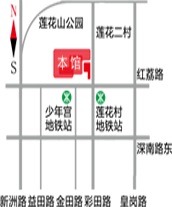
- New Exhibition | Tracing The Origin Of Brushstrokes Guan Shanyue's Sketching Journey From An Aerospace Perspective
-

Click to view organizer
Shenzhen Guanshanyue Art Museum
co-organizer
Wuhan University
Exhibition Time
May 31st to July 4th, 2025
venue
Central Hall and C Hall on the first floor of Guanshan Yue Art Museum
1. There are So Many Beauties in Jiangshan "- Jinggangshan Satellite Remote Sensing Elevation Data Digital Immersion Plate
The painting 'So Many Beauties in the Country' is a large-scale colored landscape painting created by contemporary Chinese painters Fu Baoshi and Guan Shanyue in 1959. It is now collected at the Great Hall of the People in Beijing. The painting is themed after Mao Zedong's poem "Spring in Qinyuan: Snow", depicting a beautiful scene of the vast land of China "wrapped in red and particularly enchanting" when clouds open and snow sets, and the sun rises in the east. The painting depicts high mountains and steep ridges, covered in white snow; The Great Wall stretches for thousands of miles, winding and undulating; The vast Yellow River flows endlessly and has a myriad of wonders. The images of the Great Wall and the Yellow River in the painting are full of symbolic significance, and the whole picture looks magnificent and grand, showing the vitality of New China and full of artistic charm. This section focuses on the digital display of masterpieces, integrating the trajectory of the Red Revolution, revolutionary cultural relics, related literature, and sketches. Remote sensing satellite data is connected to memorial halls, revolutionary sites, and mountain scenes, linking the "source of power" in the paintings to the scene. Integrating multiple sources, revitalizing masterpieces and expanding the narrative scope of exhibitions. This section displays 11 sketches by Guan Shanyue from Jinggangshan, 1 elevation model, and 1 interactive installation in the museum collection.
Guan Shanyue visited Jinggangshan three times in 1962, 1976, and 1977. Her series of works based on Jinggangshan are a model of the perfect integration of revolutionary themes, traditional landscape language, and the spirit of the times in modern Chinese art history. Its artistic value is not only reflected in the innovative breakthroughs in techniques, but also in exploring a unique path for traditional Chinese painting to participate in modern narrative through the scenic transformation of political beliefs, the landscape transformation of industrial power, and the totemic transformation of collective memory through the revolutionary holy land of Jinggangshan.
This section breaks through the one-way interpretation of traditional art history and reveals the triple encoding of geography, history, and art in Guan Shanyue's Jinggangshan works through spatial modeling, data mining, and other technologies. It not only represents the geographical representation of revolutionary holy sites, but also participates in ideological construction through formal language such as color and composition, ultimately forming a dynamic cultural memory carrier in digital media. The interdisciplinary interactive perspective and cross media presentation form provide quantitative support and interactive interpretation possibilities for the study of red art.
2. Drifting with the Sound of Water - Mount Wuyi Satellite Remote Sensing Elevation Data Digital Immersion Plate
In 1993, the painter Guan Shanyue went to Fujian to visit Mount Wuyi and created "Drifting with the Sound of Water" after his return, which is another masterpiece of his giant landscape paintings. The nine curves are graceful, winding around the Dan Cliff to wash away the stars, with a clear and secluded path. The Sound of Drifting with Water records the unique landscape of Mount Wuyi. The leisurely charm of "peach blossoms, flowing water, mandarin fish, and fat" has turned into ripples meandering through the clear stream; The clear sky of 'smoke fades away, sun rises, and no one is seen' condenses into the clouds that flow upstream on rice paper. This painting has a fresh artistic conception and a strong sense of life, showcasing the painter's unique and distinct artistic style. In the painting "Jiangxia Tujuan", the vast Yangtze River, splitting the Kui Gate and swallowing clouds and dreams, rushes thousands of miles towards thunder. The poetry of 'Farewell to the White Emperor amidst the colorful clouds' transforms into a ship sailing upstream against the current in the painting; The heroic sentiment of 'crossing the Wu Gorge from Ba Gorge' is condensed into the mastsail that splits waves and waves in the pen. However, arithmetic has no basis in the past and is unknown to future generations. How can it be presented and studied?
This section is based on landscape image data and intelligent technology, and looks at Guan Shanyue's footsteps and attention, relighting the profound thoughts and infinite wisdom contained in his long scroll of landscape that he measured, surveyed, and presented with his brush! This section displays two sketches of Guanshanyue Mount Wuyi and the Three Gorges of the Yangtze River, one calligraphy work, 14 remote sensing satellite pictures, one elevation model work, and three digital art works in the museum collection, which together present the ecological changes and urban development from the perspective of contemporary science and technology, so that the thousand year cultural context and construction blueprint can complete the time-space dialogue between the shades of ink.
3. Cloud Dragon Lying on the Sea Frontier - Digital Immersion Plate of Satellite Remote Sensing Elevation Data of the Xisha Islands
In 1992, Guan Shanyue went to the the Xisha Islands to collect wind and sketch. With the assistance and help of the local naval and air garrison, he was able to take a helicopter tour of the Xisha Islands and ultimately completed an important part of the "Homeland Land Group Painting" series - "Cloud Dragon Lying on the Sea Frontier". He also used the words "The Great Wall of the South China Sea guards the sacred soil, trenches and fortresses fortify the Xisha Islands" and "The Long Dragon Town connects the sea with the morning glow" to paint and sing about the Xisha Islands. The remote yet heroic momentum shows the power and magnificence of the the Xisha Islands in the vast South China Sea, and reflects the painter's superhuman generalization ability in creation. At the place where the pen is used and the ink is written, the long scroll is full of passion. It not only depicts the magnificent scenery of the the Xisha Islands, but also shows the vast and magnificent spirit of the South China Sea. Through the outline of the rugged rocks, the luxuriant croissants and the surging waves, and the color contrast, the unique geographical environment of Xisha is presented vividly and meticulously, and the soul of Xisha is truly depicted. If "The Great Green Wall," completed in 1973, is the painter's embodiment of the national spirit of "green copper walls," "Clouds and Dragons Lying on the Sea," it is a hymn to the green waters, mountains, and blue skies of the southern coast. This section displays three sketches by Guan Shanyue, two calligraphy works, three remote sensing satellite images, and one digital art piece from the museum collection.
This section will reflect the ink and waves of the painter's paintings against the blue trajectory recorded by satellite cloud images; The outline of reefs in traditional brochures is mutually confirmed with the ecological map of 3D modeling. This artistic dialogue that transcends time and space allows the painter's ink, red, and blue paintings to perfectly blend with the blueprint for building a contemporary maritime power through the interweaving of virtual and real images.
-
2025-06-10



